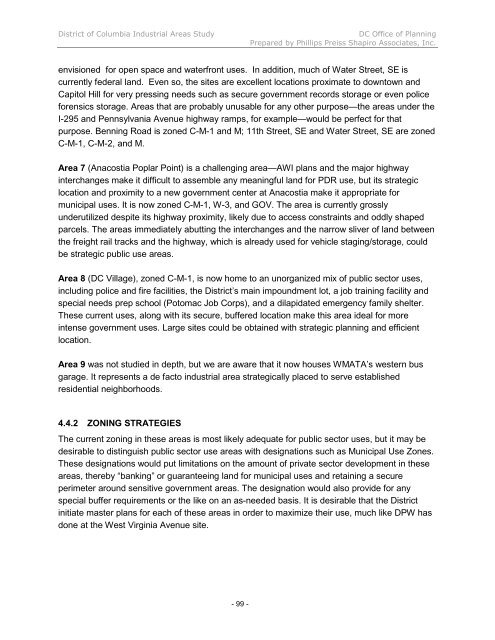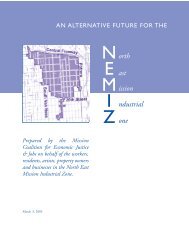INDUSTRIAL LAND IN A POST-INDUSTRIAL CITY District of ...
INDUSTRIAL LAND IN A POST-INDUSTRIAL CITY District of ...
INDUSTRIAL LAND IN A POST-INDUSTRIAL CITY District of ...
You also want an ePaper? Increase the reach of your titles
YUMPU automatically turns print PDFs into web optimized ePapers that Google loves.
<strong>District</strong> <strong>of</strong> Columbia Industrial Areas Study DC Office <strong>of</strong> Planning<br />
Prepared by Phillips Preiss Shapiro Associates, Inc.<br />
envisioned for open space and waterfront uses. In addition, much <strong>of</strong> Water Street, SE is<br />
currently federal land. Even so, the sites are excellent locations proximate to downtown and<br />
Capitol Hill for very pressing needs such as secure government records storage or even police<br />
forensics storage. Areas that are probably unusable for any other purpose—the areas under the<br />
I-295 and Pennsylvania Avenue highway ramps, for example—would be perfect for that<br />
purpose. Benning Road is zoned C-M-1 and M; 11th Street, SE and Water Street, SE are zoned<br />
C-M-1, C-M-2, and M.<br />
Area 7 (Anacostia Poplar Point) is a challenging area—AWI plans and the major highway<br />
interchanges make it difficult to assemble any meaningful land for PDR use, but its strategic<br />
location and proximity to a new government center at Anacostia make it appropriate for<br />
municipal uses. It is now zoned C-M-1, W-3, and GOV. The area is currently grossly<br />
underutilized despite its highway proximity, likely due to access constraints and oddly shaped<br />
parcels. The areas immediately abutting the interchanges and the narrow sliver <strong>of</strong> land between<br />
the freight rail tracks and the highway, which is already used for vehicle staging/storage, could<br />
be strategic public use areas.<br />
Area 8 (DC Village), zoned C-M-1, is now home to an unorganized mix <strong>of</strong> public sector uses,<br />
including police and fire facilities, the <strong>District</strong>’s main impoundment lot, a job training facility and<br />
special needs prep school (Potomac Job Corps), and a dilapidated emergency family shelter.<br />
These current uses, along with its secure, buffered location make this area ideal for more<br />
intense government uses. Large sites could be obtained with strategic planning and efficient<br />
location.<br />
Area 9 was not studied in depth, but we are aware that it now houses WMATA’s western bus<br />
garage. It represents a de facto industrial area strategically placed to serve established<br />
residential neighborhoods.<br />
4.4.2 ZON<strong>IN</strong>G STRATEGIES<br />
The current zoning in these areas is most likely adequate for public sector uses, but it may be<br />
desirable to distinguish public sector use areas with designations such as Municipal Use Zones.<br />
These designations would put limitations on the amount <strong>of</strong> private sector development in these<br />
areas, thereby “banking” or guaranteeing land for municipal uses and retaining a secure<br />
perimeter around sensitive government areas. The designation would also provide for any<br />
special buffer requirements or the like on an as-needed basis. It is desirable that the <strong>District</strong><br />
initiate master plans for each <strong>of</strong> these areas in order to maximize their use, much like DPW has<br />
done at the West Virginia Avenue site.<br />
- 99 -












